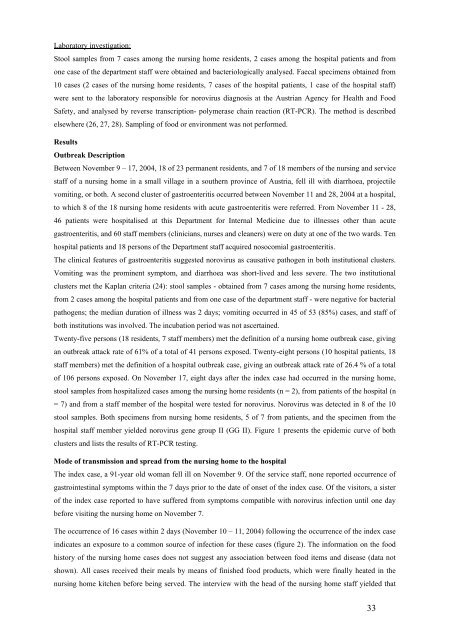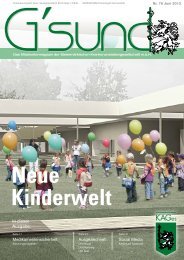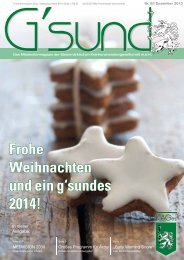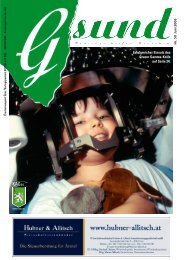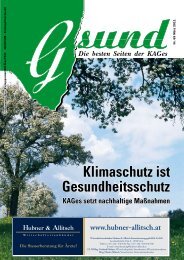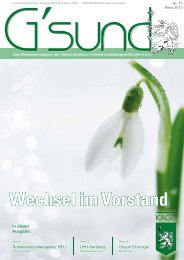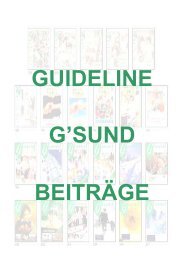Jahresbericht - Gesundheitsserver - Land Steiermark
Jahresbericht - Gesundheitsserver - Land Steiermark
Jahresbericht - Gesundheitsserver - Land Steiermark
Sie wollen auch ein ePaper? Erhöhen Sie die Reichweite Ihrer Titel.
YUMPU macht aus Druck-PDFs automatisch weboptimierte ePaper, die Google liebt.
Laboratory investigation:<br />
Stool samples from 7 cases among the nursing home residents, 2 cases among the hospital patients and from<br />
one case of the department staff were obtained and bacteriologically analysed. Faecal specimens obtained from<br />
10 cases (2 cases of the nursing home residents, 7 cases of the hospital patients, 1 case of the hospital staff)<br />
were sent to the laboratory responsible for norovirus diagnosis at the Austrian Agency for Health and Food<br />
Safety, and analysed by reverse transcription- polymerase chain reaction (RT-PCR). The method is described<br />
elsewhere (26, 27, 28). Sampling of food or environment was not performed.<br />
Results<br />
Outbreak Description<br />
Between November 9 – 17, 2004, 18 of 23 permanent residents, and 7 of 18 members of the nursing and service<br />
staff of a nursing home in a small village in a southern province of Austria, fell ill with diarrhoea, projectile<br />
vomiting, or both. A second cluster of gastroenteritis occurred between November 11 and 28, 2004 at a hospital,<br />
to which 8 of the 18 nursing home residents with acute gastroenteritis were referred. From November 11 - 28,<br />
46 patients were hospitalised at this Department for Internal Medicine due to illnesses other than acute<br />
gastroenteritis, and 60 staff members (clinicians, nurses and cleaners) were on duty at one of the two wards. Ten<br />
hospital patients and 18 persons of the Department staff acquired nosocomial gastroenteritis.<br />
The clinical features of gastroenteritis suggested norovirus as causative pathogen in both institutional clusters.<br />
Vomiting was the prominent symptom, and diarrhoea was short-lived and less severe. The two institutional<br />
clusters met the Kaplan criteria (24): stool samples - obtained from 7 cases among the nursing home residents,<br />
from 2 cases among the hospital patients and from one case of the department staff - were negative for bacterial<br />
pathogens; the median duration of illness was 2 days; vomiting occurred in 45 of 53 (85%) cases, and staff of<br />
both institutions was involved. The incubation period was not ascertained.<br />
Twenty-five persons (18 residents, 7 staff members) met the definition of a nursing home outbreak case, giving<br />
an outbreak attack rate of 61% of a total of 41 persons exposed. Twenty-eight persons (10 hospital patients, 18<br />
staff members) met the definition of a hospital outbreak case, giving an outbreak attack rate of 26.4 % of a total<br />
of 106 persons exposed. On November 17, eight days after the index case had occurred in the nursing home,<br />
stool samples from hospitalized cases among the nursing home residents (n = 2), from patients of the hospital (n<br />
= 7) and from a staff member of the hospital were tested for norovirus. Norovirus was detected in 8 of the 10<br />
stool samples. Both specimens from nursing home residents, 5 of 7 from patients, and the specimen from the<br />
hospital staff member yielded norovirus gene group II (GG II). Figure 1 presents the epidemic curve of both<br />
clusters and lists the results of RT-PCR testing.<br />
Mode of transmission and spread from the nursing home to the hospital<br />
The index case, a 91-year old woman fell ill on November 9. Of the service staff, none reported occurrence of<br />
gastrointestinal symptoms within the 7 days prior to the date of onset of the index case. Of the visitors, a sister<br />
of the index case reported to have suffered from symptoms compatible with norovirus infection until one day<br />
before visiting the nursing home on November 7.<br />
The occurrence of 16 cases within 2 days (November 10 – 11, 2004) following the occurrence of the index case<br />
indicates an exposure to a common source of infection for these cases (figure 2). The information on the food<br />
history of the nursing home cases does not suggest any association between food items and disease (data not<br />
shown). All cases received their meals by means of finished food products, which were finally heated in the<br />
nursing home kitchen before being served. The interview with the head of the nursing home staff yielded that<br />
33


